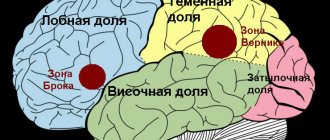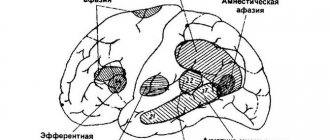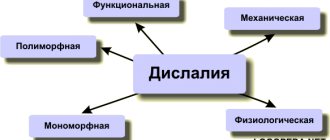Speech difficulties are a disorder of speech activity, due to which normal communication and social interaction of people with society is impossible. A violation is indicated by deviations in the functioning of the psychophysiological mechanisms of speech if the development does not correspond to age.
One of the defects is slurred speech, which makes it difficult for a person to communicate. Speech therapists, neurophysiologists, neurologists, otolaryngologists and other specialists study and treat such difficulties. They work with adults and children.
Why does it appear in adults?
Slurred speech in adults may appear suddenly or develop gradually. It can also occur in children. Specialists first find out why this happened, and only then begin treatment. Slurred speech can occur due to several factors. The reasons are as follows:
- Brain disorders.
- Brain injuries caused by stroke or thrombosis.
- Head injuries.
- Brain tumors.
- Degenerative diseases.
- Excessive alcohol consumption.
- Weakness of facial muscles.
- Weak or tight fastening of dentures.
Types of violations
Slurred speech of phonation (external) design appears separately and together with other disorders. In speech therapy, there are the following types of disorders:
- Aphonia and dysaphonia. There is a disorder or absence of phonation due to pathologies of the vocal apparatus. Usually there is a violation of the pitch, strength, and timbre of the voice.
- Bradylalia. Speech rate slows down. A particular feature is the slow implementation of the articular speech program.
- Tahilalia is an acceleration of the rate of speech. Accelerated articulatory speech program.
- Stuttering. The organization of speech is disrupted when the muscles of the speech apparatus undergo spasms. Usually appears in children.
- Dislalia. This pathology is presented in the form of a disorder in the pronunciation of sounds, when a person’s hearing and innervation of the speech apparatus are normal. The distorted sound design of words appears. This is slurred speech. The sound may be pronounced incorrectly, replaced or mixed up.
- Rhinolalia. The pronunciation of sounds and voice timbre is impaired, which is associated with disorders of the speech apparatus. Changes in voice timbre appear when the vocal stream of air passes into the nasal cavity during exhalation and pronunciation. This causes resonance.
- Dysarthria. Pronunciation is impaired, which is associated with insufficient innervation of the speech apparatus. This disease occurs due to cerebral palsy, which is detected at an early age.
Causes and risk factors
Classification of a pathological condition involves division into organic and functional. The disorder may be a consequence of central nervous system dysfunction and hearing impairment. Also, its occurrence is caused by injuries and bruises of the head, damage to the speech organs. This could be a brain tumor, stroke, thrombosis. In older people, there is a connection with Alzheimer's and Parkinson's diseases. In this case, pathological memory disorders and mental disorders occur in parallel. Less commonly, epilepsy, alcohol abuse, cerebral palsy, and infectious diseases of the brain contribute to dysfunction.
The functional causes of speech disorder are considered to be external factors, for example, stress, fear, hysteria, untreated pathology from childhood. Under the influence of taking certain medications (antidepressants, tranquilizers), auditory perception may decrease, which aggravates speech disorders. An important role is played by the hereditary factor. If there is a predisposition, it is necessary to monitor the person’s condition over time.
The simultaneous influence of external and internal causes is possible, in which case the picture of disorders becomes multi-layered and manifests itself in a large number of symptoms.
A person’s communication functions also suffer when dentures are installed incorrectly. A deep state of stress and overexertion can lead to spastic dysphonia. In this case, tension in the voice or its disappearance is noted.
Structural and semantic design of speech
Based on this criterion, disorders are divided into 2 types: alalia and aphasia. Each type of disease has its own symptoms. Alalia manifests itself in the form of absence or incomplete development of speech. This occurs due to damage to the areas of the brain that are responsible for it. The disorder may appear during fetal development or at an early age.
With alalia, slurred speech appears. This defect is considered one of the most complex, since speech activity is not fully formed. Aphasia is the loss of the ability to speak due to local damage to the brain. Why does slurred speech occur with this disorder? It is associated with traumatic brain injuries, neuroinfections and brain tumors.
Distortion of speech due to dysarthria
Speech dysarthria is not considered an isolated disease. This is a symptom that manifests itself in a disorder of all speech characteristics: tempo, intonation, volume, consonance, clarity, etc. As a result, speech becomes slurred.
The cause of the disorder is damage to the parts of the central nervous system responsible for the innervation of the speech-motor apparatus. Dysarthria in adults can develop as a consequence of a stroke, tumor or brain injury. It also accompanies patients with amyotrophic and multiple sclerosis, Parkinson's disease, and occurs in mental retardation, neurosyphilis, and other pathologies affecting the brain.
A whole system of organs is involved in the formation of words. These are lips, tongue, cheeks, larynx, palate, respiratory and facial muscles. With dysarthria, these elements do not work in a coordinated manner. The reason for this is damage to the following nerves:
- sublingual;
- glossopharyngeal;
- facial;
- trigeminal.
In this case, inadequate functioning of the tongue is observed: limited movement of the tongue to the sides, up, down. He is in a tense state, which is why he gets tired quickly, and asymmetry of the lesion may be observed.
The cheek muscles also lack coordinated movements. This reduces the ability to correctly maintain posture when pronouncing sounds. Movement of the lower jaw is difficult. The lips are excessively compressed or, conversely, relaxed, the tongue lies at the bottom of the mouth, and the pliability of the soft palate is also impaired.
Motor stiffness, tension, paresis and paralysis of the facial muscles lead to the fact that the speech of such a patient becomes incomprehensible, unclear and difficult to perceive. It is often characterized as porridge in the mouth.
Speech defects manifest themselves to varying degrees, depending on the area and extent of the lesion. There is an articulation disorder in pronunciation. A person does not pronounce almost all sounds, both vowels and consonants. Often hissing and whistling sounds have interdental or lateral pronunciation, the correct sound of voiced and hard consonants is lost, and defects in the pronunciation of “l” and “r” and sounds with posterior pronunciation appear.
Front-lingual letters (“d”, “t”, “z”, “s”) are pronounced with an interdental whistle. Complex sounds are replaced by simpler ones. Speech either unnaturally slows down, becomes drawn-out, or, conversely, accelerated. Gaps appear between letters and letter substitutions occur.
The voice also undergoes changes. It loses its volume, becoming quieter and weaker. The timbre becomes nasal and dull. Speech is monotonous, without emotional coloring. The intonation of the voice is lost: interrogative, narrative, exclamatory. Speech rhythm is inconsistent, stress placement is disrupted.
Due to problems with innervation, speech breathing also changes. During pronunciation it becomes more frequent, chaotic and intermittent. It’s as if the person doesn’t have enough air to finish the sentence.
Thus, speech impairment in dysarthria is polymorphic in nature, that is, it undergoes changes in all its characteristics. They are quite stable.
Diagnostic features
It is necessary to analyze the complaints expressed by the patient. The medical history is also taken into account. Experts usually ask when the slurred speech appeared and whether there are any relatives suffering from such an illness. You definitely need to visit a neurologist and get examined by him. The doctor will check the mandibular and pharyngeal reflexes, examine the pharynx, and make sure there is atrophy of the tongue muscles.
The reflexes of the lower and upper extremities are checked. You should be examined by a speech therapist. The doctor evaluates speech indicators, identifies tempo disturbances and difficulties. An examination by an otolaryngologist is necessary, which will protect against processes in the mouth such as ulcers and tumors, which can cause problems.
A computed tomography and magnetic resonance imaging scan of the head is performed, which will help identify the cause of slurred speech. The causes in adults and children are determined in consultation with a neurosurgeon. Only after a complete diagnosis are treatment methods prescribed.
Incoherent speech in a child. What to do?
Each child goes through certain stages in his development and, finally, the moment comes when he begins to speak.
Subsequently, speech develops - it becomes clearer, grammatically correctly formatted, expanded, conveying semantic load and consisting of logically related sentences, thus the child’s speech gradually forms and becomes coherent.
Coherent speech is divided into two types - monologue and dialogic. When speaking dialogically, you need to be able to correctly ask questions and answer them so that the interlocutor understands the main idea, wants to answer the questions as fully as possible, and also receives all the necessary information from you. Monologue speech consists of a coherent, logically structured and emotionally charged story.
Incoherent speech
But sometimes it happens that at some stage of development, parents notice that the child’s speech is “blurred”, phonetics are disrupted, the tempo of speech is disturbed and/or the child rearranges syllables and cannot convey the main idea of his statement. While talking to you, the child is constantly distracted by a “crow flying past”, loses the main idea of his story (or dialogue) and finds it difficult to concentrate and remember what it is all about. The statement may consist of sentences that are not structured logically, and may also contain grammatical errors in the construction of the phrase (there are a lot of cars on the road).
If you do nothing about such manifestations, then in the future this will lead to errors not only in the child’s oral speech, but also in written speech. The child will encounter difficulties in school learning (difficulty writing a presentation or essay, errors in the rules of the Russian language, difficulties in reading and understanding the meaning of a problem in mathematics and other subjects, and as a result, lost knowledge and poor performance).
The inability to construct your statement, to correctly formulate your thoughts can also lead to difficulties of a psycho-emotional nature: self-doubt, the emergence of various complexes, difficulties in establishing contact and communicating with peers and adults.
What to do?
It is very important to contact a specialist in a timely manner - a speech therapist - defectologist, who will conduct a speech therapy examination, find out the causes and degree of speech development disorders, give a detailed consultation with recommendations and conduct a course of individual correctional and developmental classes with the child.
All these measures will help the child avoid further difficulties in development, acquiring new knowledge and communication. Your child will study successfully and with pleasure, and there will be many interesting friends around him.
Principles of treatment
If slurred speech is detected, what to do? It is necessary to treat the main disease that caused the disorder:
- Tumors are removed surgically.
- Resection of the hematoma if it is on the surface.
- Surgical removal of ulcers in the skull followed by the administration of antibacterial agents.
- Normalization of pressure.
- Using drugs to restore metabolism and cerebral blood flow.
People with various disorders need to visit a speech therapist so that the deficiency can be corrected with the help of special exercises. Regular classes are required.
Slowing down aphasia
To improve the patient's overall condition, careful care and patience on the part of the caregiver will be required. With dementia, the patient is spoken to slowly, pronouncing words clearly. This helps to grasp the essence of what was said and build a logical chain of thoughts received. Neurolinguists and psychotherapists recommend simple exercises:
- Reading short passages of text with an attempt to present what was read.
- Board games with a logic connection: monopoly, mafia, pulling wooden blocks from a solid tower, walker games with throwing dice.
- Solving Sudoku problems, crossword puzzles on recalling words, calculating cells and painting the resulting picture.
- Playing a musical instrument, especially if the person has previously learned to play music.
- Regular communication by name.
According to research by Canadian scientists in 2015, it was concluded that adherence to an algorithm of psychotechnics for maintaining and restoring speech expression, based on the practice of mindfulness, slows down the process of progression of dementia.
Important! An alarming sign of incipient dementia with aphasia is speech “stumbling”, expressive expression of thoughts with forgetting of some words or sounds. Subsequently it develops into logoclony (disorder in the morphology and syntax of words).
Stimulation of the brain center will help slow down as much as possible the onset of speech changes with their subsequent loss.
Rules for correcting speech
Speech impairment appears not only due to pathology of the articulatory apparatus, neurological pathology and the habit of incorrect pronunciation. Another factor is psychological. When excited, a person’s speech becomes barely audible and almost incomprehensible.
The work of a speech therapist to restore speech is based on the following principles:
- Personal orientation.
- Creating an emotionally favorable environment.
- Interaction with parents.
- Positive motivation.
Speech therapy classes involve improving the mobility of the articulatory apparatus. We are also working on sounds and restoring phonemic hearing. Specialists work with children in a playful way, using speech games and a computer. Combined activities are carried out that involve switching attention from one activity to another.
Rules for speech formation
Classes with a specialist allow children to develop literate, phonetically clear speech. But such events will not be enough. The speech therapist only helps with sound production. Everything else depends on the child and parents.
In order for speech to be successfully formed, the following rules must be observed:
- You should not scold your child for slurred speech, you just need to carefully correct it.
- Simple exercises should be shown.
- There is no need to focus on mistakes or stumbles.
- It is necessary to have a positive attitude towards classes with a speech therapist.
- Parents also need to watch their speech.
Prognosis and prevention
Speech disorders can be corrected if this work is started at an early age or early stage. The people around us and the efforts of the person himself play an important role in improving the condition. If the disorder is identified in a timely manner and treatment is started, speech can be normalized. Such children continue to study in regular schools and get along well with the kids.
In complex forms of the disease, achieving improved speech is not easy. You can only correct your speech function. In such situations, the range of measures is broader, and the patient needs to visit a specialized institution. It is necessary to maintain the continuity of speech therapy organizations: go to special kindergartens, correctional schools. It is also important to be treated in psychoneurological hospitals if it was prescribed by a doctor.
Prevention involves implementing effective measures from birth. The child must be protected from neutroinfection, skull and brain injuries. It should not be affected by toxic factors.
It must be taken into account that success comes with a systematic approach and comprehensive organization of events. Along with traditional treatment, unconventional methods should not be forgotten. It is important to carry out physical activity activities. Using a variety of methods can provide excellent results if used correctly.









